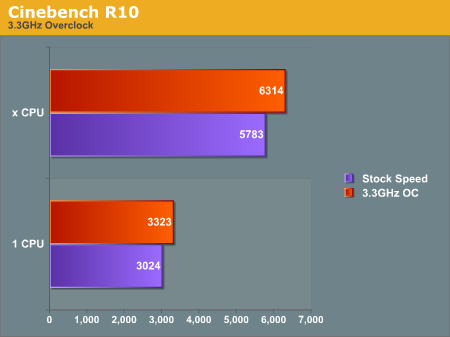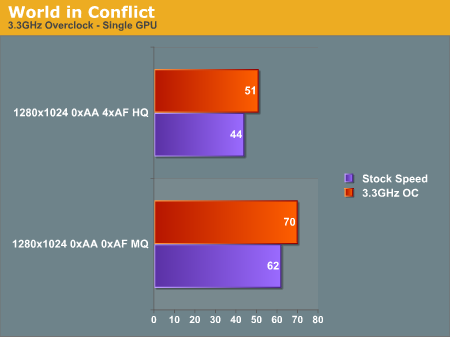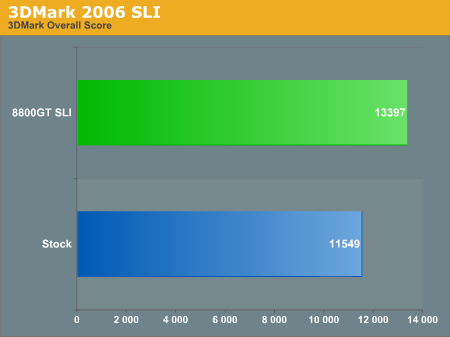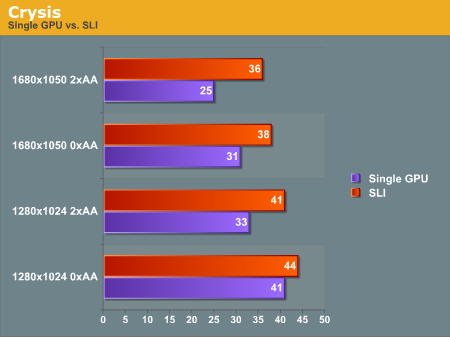Überclok Ion: Midrange Overclocking, with a Warranty
by Matt Campbell on February 12, 2008 4:10 AM EST- Posted in
- Systems
Overclocking (higher) and SLI
We've seen what the Ion can do as configured out of the box, but what about pushing it even farther? Where would upgrades be most effective? To answer these questions, we examined two possible paths to increasing performance: a faster processor and the addition of another 8800 GT for SLI.
Overclocking (higher)
Ok, so we voided the warranty - but with the Tuniq, airflow, and thermal protection, odds are extremely unlikely that a little experimentation will hurt. We opted to stay conservative, pushing the E4500 up another 300 MHz to 3.3GHz. Does this provide any gains at all?



What do the above tell us? In our Cinebench CPU benchmark, a 10% increase in clock speed gives us about a 10% increase in score. With a control test established, we move on to gaming performance. At 1280x1024, we see large gains in performance in World in Conflict. Clearly, a faster CPU will aid greatly in this strategy game. In Crysis however, we see a clear hinge point, with a noticeable increase at 1024x768 and almost zero change at 1280x1024. As we found in our Shuttle review, the 8800 GT becomes completely GPU-bound at resolutions of 1280x1024 and higher.
8800 GT SLI
Now that we've looked at overclocking, what kind of a performance increase would we obtain if opted for another 8800 GT instead? We lowered the clocks of the Ion system back down to 3.0 GHz ("stock") and added another 8800 GT. The expandability of the system is really what facilitated this test; because the motherboard is SLI and the power supply is readily able to handle another video card (with an included PCIe power cable), installation was a 5-minute affair. What kind of numbers do we see now?



The synthetic benchmark shows a 16% performance gain at 1280x1024. Is this indicative of what we see in games? Not really - we have different constraints coming into play. World in Conflict is CPU hungry, as we showed in the overclocking section, and no increase at all is seen at up to 1680x1050 without antialiasing. Once we enable 4xAA, we do indeed see an increase, but it's still not tremendous. Crysis is a completely different story; while a CPU increase had little effect at 1280x1024 and above, the SLI configuration yields gains of up to 44%.
Which upgrade makes more sense? The above graphs are just a snapshot of performance, but depending on your monitor (i.e. the resolution you play games at) and the games you play, either upgrade could provide a reasonable performance boost. A CPU upgrade will help in many strategy games that tend to tax that area more, as well as Flight Simulator X; an E8400 at 4.0 GHz is an available upgrade on the Ion for $160, vs. a $290 upgrade for dual 8800 GTs, also making it an attractive choice cost-wise.
Crysis is somewhat unique in how much it relies upon a blazing fast graphics subsystem. If you intend to play Crysis at higher detail settings, then clearly you'll want to pony up for more GPU power as a CPU upgrade buys you nothing at higher resolutions. However, other games also demand a fast graphics subsystem, and more will likely come out in the near future. Obviously, if you want better performance in all situations, a faster CPU and a second GPU is the way to go, though at $400+ that's certainly not a cheap upgrade to make. One final thought is that you can always add a second GPU later and lose nothing; if you decide to upgrade CPUs down the road, you'll end up with a spare CPU. Thus, we'd recommend spending a bit more in the processor area if you can manage it.










38 Comments
View All Comments
nubie - Wednesday, February 13, 2008 - link
Have you ever considered a PC Power and Cooling power supply? The Silencer 610 offers a single 12-volt rail at 49 Amps and is also Nvidia SLI certified for $50 cheaper (assuming retail). I like your product, but I feel that the power supply isn't the wisest choice.I realize that the Thermaltake is a "52 Amp" power supply, but with 4 power rails it is a moot point because all of the power is not available for use when split. The Silencer is rated at 49Amps anyway, so nearly the same.
Uberclok - Wednesday, February 13, 2008 - link
We are very impressed with PC Power & Cooling, and always consider their products when specing out a new model. Unfortunately, they tend to cost quite a bit more than competing models without a truely compelling benefit. The Silencer 610 is only SLI-certified for dual 7900 GTX cards or lower, so it won't work for our Ions. The least expensive PP&C PSU which is SLI-certified for the 8800 GT card is the Silencer 750 Quad, which retails for about $25-$50 more than the Toughpower. That's almost compelling enough to switch, but our customers tend to like a clean interior, so we actually view PP&C's lack of modular cabling as a drawback, not a plus (despite the increased electrical resistance of modular cables.)- Thomas Glen
Uberclok
(877) 211-4235
thomas.glen@uberclok.com
strikeback03 - Wednesday, February 13, 2008 - link
You forgot an operating system, assuming you will use Windows legally that adds at least $100. The P35 chipset cannot officially do SLI, and I highly doubt you find a similar case/PSU/pair of DVD drives for $120 regularly - cheaper case and less powerful PSU would be doable. I'm guessing you also are planning on stock CPU cooling, and you specified a smaller hard drive. So yes, if you know exactly what you want your computer to do over its life then you can save a bunch of money. If you build for future expansion (such as this system) I'm guessing your total will be closer to what they calculated.nubie - Tuesday, February 12, 2008 - link
I have only 20, minus taskman, utorrent and Firefox that is 17.I take offense to iTunes, it has crapped on my system too many times, and refuses to install on a regular basis for me. I don't own an iPod, I can't spend the money on one because they are the same price as a computer or a car for me (take your pick, my last 5 computers and cars cost $500, $300, $200 and $400), so why do I need APPLE running 5 programs to update "my" ipod?
Pre-loading should be optional. And nTune is a huge pile as well, never helps anyway. For Video card the Classic control panel will check temps and run frequency adjustments. And for the motherboard there is ClockGen and GCPUID.
These problems are really the fault of Apple and nVidia for bloatware. Divx is bloatware/adware as well.
As nice as this system is, I wouldn't buy one myself (since when is the 8800GTS 512 $100 more than the 8800GT 512?), and I couldn't recommend it without also suggesting that the OS be "un-loaded" of the crap.
Nice case and HS/FAN though.
Uberclok - Wednesday, February 13, 2008 - link
You make an excellent point about the 8800 GT/GTS pricing - we needed to adjust to account for recent price drops. Our website now reflects a $50 difference between the two cards (single and SLI.)Although I can understand wanting to run such a lean system, I'm still quite proud of how little 3rd-party software we ship on our PCs. Everything we do include was selected because it contributes in some significant way to giving our customers a smoother out-of-the-box experience, is innocuous, doesn't annoy them, and doesn't slow down the PC.
We include iTunes simply because it's such a good stand-alone music and video app, whether you have an iPod or not. It's a very easy way to get quick access to dozens of streaming internet radio stations, podcasts, and cheap TV shows and movies.
nTune is included solely for nVidia Monitor. Most of our customers won't be using it to adjust any settings.
Divx can be bloatware/adware if you install the whole package, but we only include the codec and the player, so there aren't any "trial" components (that kind of thing bugs us too.)
- Thomas Glen
Uberclok
(877) 211-4235
thomas.glen@uberclok.com
7Enigma - Thursday, February 14, 2008 - link
Thomas,I wanted to thank you for all the replies I've read in the comments section by you, and in turn, your company. It is refreshing to see such direct replies, especially in reference to some of the more heated/argumentative posts.
I think if your company is run in a similar fashion to the way many of us build systems (ie the search for the best QUALITY bang for the buck in each category) it will be very successful. Please note the key word of QUALITY. Many companies are out there that can build a "wicked fast" system for cheap (along with the cheap components), I and anyone in the know will appreciate using quality parts to get the same or slightly less performance knowing they have a rock solid rig.
I also think sites like Anand's will be vital to the success of your company. Simple things like the cpu cooler and power supply roundups will let you guys get the real data on what parts perform exceptionally well at a particular price point, and should ultimately improve your bottom line and keep system costs down to the consumer.
While I build my own systems (its fun!) I will have no problem recommending your company to potential customers in the future. Please just make sure a simple Google search yields a hit on your site!
nubie - Wednesday, February 13, 2008 - link
Thanks for clarifying :), I agree on your point about Divx, if it is only a codec and player. I am happy to see that you have reflected the market with the video card pricing.7Enigma - Wednesday, February 13, 2008 - link
I agree with you on iTunes. I remember when my Alienware (see 3rd or so post of the comments for backstory) was delivered to my house. I booted it up to what you saw on the desktop with this system and that was it. No 3rd party programs at all. This was well before Firefox was even conceived (could have probably dl'd Netscape Navigator at that time!), and it was so nice and refreshing to not have to spend an hour deleting all the bloat (or reformatting if it would be faster). Oh and all the driver disks were together in a nice sleeve of the binder (like baseball trading cards). I have no idea how Alienware has evolved since then (especially by being purchased by Dell), but back then while pricy, it was the CREAM of the crop (along with Falcon Northwest, but those were just sickeningly expensive....$4,000-5,000...certainly don't miss those days).If the company is watching these comments here's a very easy way to gain respect on both sides (to install or not to install):
-Put all these 3rd party programs you installed INSTEAD on a cd included with the binder. You can even include a short description of what each program is/does and then let the buyer decide to install or not.
I personally believe Firefox should be a defacto standard on any new PC, but again it should be the owner's choice to install it, not the company selling the product. I like Firefox, someone else might prefer a different 3rd party browser.
HaZaRd2K6 - Tuesday, February 12, 2008 - link
Owning a Nine Hundred, I'd love to get a closer look at how they kept the cables so neat. Any chance you could upload the full picture of the case interior, there? :)KikassAssassin - Tuesday, February 12, 2008 - link
Yeah, that's an incredibly clean cabling job for a Nine Hundred case (the lack of places to route wires is my one gripe with my Nine Hundred).From the picture, it looks like they probably put a snakeskin around the cable bundle to keep everything together and make it look neater. It's a good solution, though it might mean you'd have to take the whole bundle out if you wanted to change one of the cables for whatever reason.